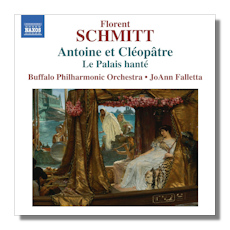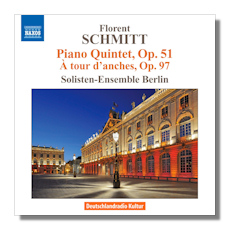
The Internet's Premier Classical Music Source
Related Links
- Latest Reviews
- More Reviews
-
By Composer
-
Collections
DVD & Blu-ray
Books
Concert Reviews
Articles/Interviews
Software
Audio
Search Amazon
Recommended Links
Site News
 CD Review
CD Review
Florent Schmitt

Orchestral Works
- Antoine et Cléopatre
- Le Palais hanté
Buffalo Philharmonic Orchestra/JoAnn Falletta
Naxos 8.573521 2015 59:33


Chamber Works
- Piano Quintet, Op. 51
- À tour d'anches, Op. 97
Birginna Wollenweber, Piano
Soloisten Ensemble Berlin
Naxos 8.570489 2008 73:47
When Florent Schmitt (1870-1958) died after a long and productive life, a critic wrote that "French music has just lost a smile and a master." He was famous for humour, energy and wit, according to Caroline Waight in the notes to the earlier of these two Naxos releases. He worked as a critic as well as composer and, for a time a, conservatory director.
Born in Lorraine just at the time that traditionally French province was taken by Germany for half a century, Schmitt spent his life in France. At the Paris Conservatoire he studied composition with Fauré and Massenet and became a friend of Ravel. He was influenced by Debussy, Fauré, Chabrier and others, but Edward Burlingame Hill, in Modern French Music, written in 1924, credited him with "a strong and independent personality among the conflicting tendencies of his generation." Schmitt won the grand Prix de Rome, and was awarded the distinction of the Légion d'honneur. He defeated Stravinsky in an election to the Académie des Beaux-Arts, at the expense of a friendship between the two composers.
Professionally successful in his time, Schmitt is too much neglected at the present time. Some of his most highly regarded orchestral and chamber compositions are represented on these two CDs. Both Naxos and Falletta are to be commended for this. Schmitt's piano and choral works are also represented on available recordings.
Le Palais hanté (The Haunted Palace), an early work, was inspired by a Mallarmé translation of an Edgar Allen Poe poem included in The Fall of the House of Usher. Only half of the English text is quoted in the CD's notes, expressing the more lyrical aspects of this symphonic poem – regrettably, as the music becomes more intense in its later parts.
Antoine et Cléopatre – Six épisodes symphoniques en deux suites d'après le drame
de Shakespeare was written in 1920 as a set of dance episodes between the acts of this tragic play. They are divided into two suites of three numbers each totaling about forty seven minutes, a considerable addition to an already very long evening. The premiere, in the Paris Opéra, was in a French translation by André Gide and with dancing by Ida Rubenstein in the role of Cleopatra
Half of the first suite is devoted to Antony and Cleopatra themselves, followed by an evocation of the camp of Pompey (who was along with Antony, another of the Roman triumvirate) and then an evocation of the battle of Actium, which precipitated the beginning of the Roman Empire following hundreds of years of the Roman Republic. The camp episode begins quietly but its manner segues into the battle scene, which is predictably loud. (The changing mood of the camp mirrors in a way the change in Le Palais hanté ). The second suite (and I shall simply translate the French titles here) consists of Night in the Palace of the Queen, Orgy and Dances, and The Tomb of Cleopatra. There is a nice description of musical effects, written by Edward Yadzinski for the CD notes. He particularly notes the oriental modes given to the oboe, English horn and French horns, as well as some brass fanfares and more jagged brass rhythms. My personal preference is for the quieter movements over the ones suggesting violence.
Schmitt's Piano Quintet, written between 1905 and 1908, "created a genuine sensation, and from this moment its composer's position was assured," Edward Burlingame Hill – who lived in France at that time – reports in the book mentioned above. In three movements, and at nearly an hour in duration, it has to be one of the longest works of its kind. The opening and closing movements are each well over twenty minutes. The first movement, Lent et grave – Animé, after an unusual and quietly appealing opening, holds the attention with the help of Schmitt's use of counterpoint. The piano tends to dominate the string quartet, which plays mostly in melodic unison, with no notable solos for the individual instruments. The slow movement, Lent, is lovely, with the piano sometimes limpid. The final movement, Animé, is significantly more forceful and varied in mood and character than the others. The Quintet rewards repeated listening. I like it increasingly.
À tour d'anches is not an easy title to translate but, as I make it out after a struggle with Le Petit Larousse, it celebrates the sounds of reed instruments, in this case oboe, bassoon and clarinet playing in partnership with the piano, which is not dominant in this work. One of Schmitt's last works, written during World War II, this woodwind and piano quartet defies the mood of that time, as it is mostly light and lively, especially the very brief first and last of the four movements. If I had to compare this to the music of any other composer, that would be the music of Poulenc, who managed to summon lively cheerfulness after the First World War. The first movement is called Courre, which means chase, and the finale is called Quasimodo, after Victor Hugo's character. Movement 2 is Sur un rhythme prévu (meaning an expected rhythm, which I shall leave to the listener to anticipate) and the lovely third movement is marked Nocturne – sarabande and is nearly the length of the other three altogether.
The performances and recording quality here are excellent and I can recommend both of these very welcome discs.
Copyright © 2016, R. James Tobin





















